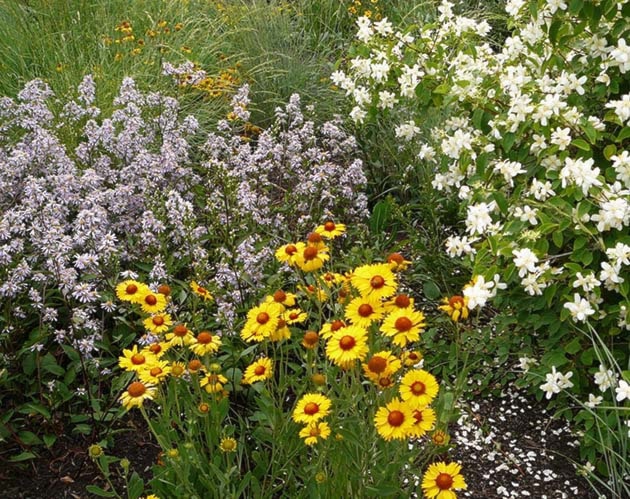An area planted with Okanagan native species can be one of the lowest maintenance options to replace a lawn.
Plants that thrive in our dry natural landscape are adapted to Okanagan climatic conditions so once established should not need supplemental water.
Using native plants restores much needed habitat for birds and other wildlife that we have displaced. Their visits add another interesting dimension to a garden.
There are many Okanagan native plants available.
Two nurseries that specialize in these are Wild Bloom on Rutland Road in �������� and Sagebrush in Oliver. You can access their plant lists and websites through the OXA plant database at www.okanaganxeriscape.org.
Native shrubs, in sequence of bloom, begin early April with Saskatoon and Oregon grape. Wild currants (Ribes cereum) and gooseberries are next followed by mock orange then wild roses (Rosa woodsii) and snowberry. Ocean Spray (Holodiscus dicolor) is later and last is native elderberry (Sambucus caerulea).
In addition to providing nectar to pollinators most of them produce berries to feed birds. With the exception of snowberry all are edible for humans.
I grew up eating delicious jelly made by my grandmother from berries in her Oregon grape hedge on Marshall Street.
If you have Ponderosa pines on your property, the native plant garden could centre around them. They do much better without irrigation and it is hard to grow lawn under them.
Kinnickinnick and pussytoes are two ‘evergreen’, flat ground covers that grow under pines in the wild.
Most of the shrubs listed are found in association with pines.
Big sagebrush (Artemesia tridentata) and rabbitbrush (Ericameria nauseosa) are two very attractive, extremely drought tolerant shrubs. Both have silver foliage. Rabbitbrush is blooming now with sulphur yellow flowers.
These are found on dry hillsides amongst bluebunch wheat grass which is now in its tawny, dormant phase.
Some wildflowers to use to create a meadow with the bunch grass are early-blooming nodding onion (Allium cernuum); long-blooming showy aster, brow-eyed susan, blue flax (Linum perenne), golden aster (Heterotheca villosa) and yarrow.
Milkweed (Asclepias speciosa) can be added for butterflies.
Late blooming pearly everlasting (Anaphalis margaritacea) and Aster ericoides add a touch of white.
Check the OXA plant database for more native plants, photos and extensive details about each species.
To narrow down what would do well on you site conditions take note of how sunny it is and if the soil is sandy/gravelly/fast draining or water retentive/clay-like. Then find areas in the wild that have similar conditions and see what is growing there.
If you happen to have a stream or pond you are planting adjacent to, check out riparian areas such as Mission Creek Greenway or local ponds.
My two night ‘Introduction to Xeriscape Gardening’ classes are filling up quickly. They are on Wednesday, September 21 & 28, and Monday September 26 & October 3 from 7:00pm to 9:00pm at St Michael and All Angels Cathedral Hall, ��������. For details and to register go to: www.okanaganxeriscape.org.



